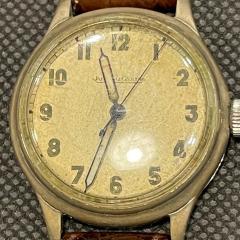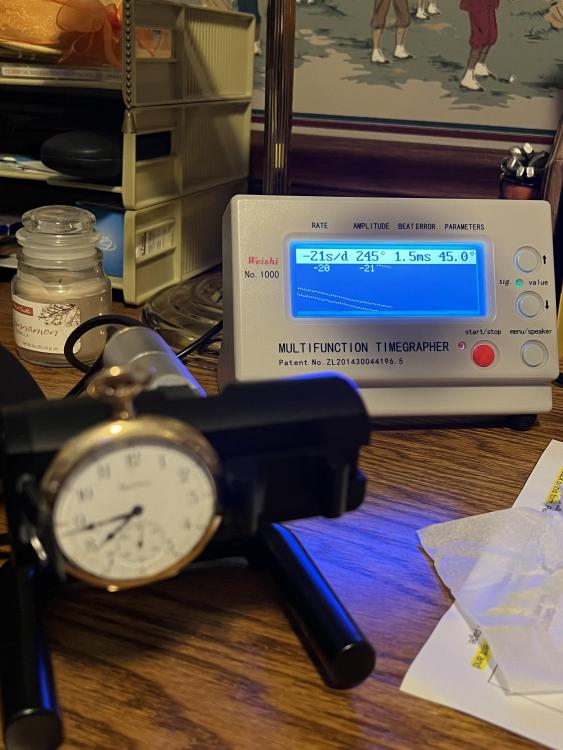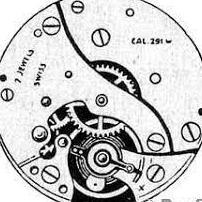Leaderboard
Popular Content
Showing content with the highest reputation on 11/28/22 in all areas
-
Finally found a time window to sort out the low amplitude issue on my lovely non-Mumbia Favre Leuba. The only job left to sort was the replacement of the twin mainsprings - pure cowardice. I'm delighted to say it has transformed to amplitude from 215 to 275 degrees so worth doing but not a beginners job. Here's what was learnt from the struggle which should help fellow watch menders. Forget about getting the exact spring from Favre - the new company is another resurrected imitation. According to Dr Ranfft you are looking for 1.55 x 6.5 x 0.065 x 210. Another site suggests a 270 mm length. The old springs were tired but 270 mm long so looking at the fill in the 6.77 mm internal barrel diameter using the longer length looked the way to go. The nearest Cousins UK had in stock was GR4052 which is 7.5 mm diameter so they will need to be unwound and rewound into a 6.5 mm winder barrel. At over £20 each inc VaT this was expensive - Gleaves & Sons had 1.5 x 0.7 x 285 x 7 mm dia for £6 each so they got the order. It still meant rewinding so make sure you have the small winding tools this requires. The barrel design is probably unique. To save height there is no barrel top - instead the winding wheel sits on top of the open barrel and covers the spring. It has a hollow stem which forms the arbor and has the spring hook on this sleeve. The barrel has a hollow stem and one fits over the other - very neat. It's a pig to get apart. Use your sprung hand puller hooked under the geared cover as shown in the pictures. Next problem is that the new spring will have the inner circle in too large a diameter so that the arbor hook will not engage with the attachment slot. I tried a few tricks but the one that worked was to go ahead and install the spring in the open barrel. Then using flat ended strong tweezers squeeze the spring end to tighten that last curve until the wheel/arbor grabs. Patience and trial and error will be required.... It can be done before inserting the spring but make sure you put a drill through the middle to squeeze against thus preventing the brittle metal from snapping. 1.2 mm proved to be the best size. However I would suggest you do it after the spring is in the barrel since it makes it easier to thread in your winding tools. The hollow spigot in the barrel works as a handy former to shape the spring against. Don't forget to put a drop of HP 1300 or something similar on the outside and inside of the barrel spigot. Note that the spring should be CLOCKWISE in the barrel - ie starting from the centre it curves clockwise. Helpfully the neat design means that both barrels run the same way so are identical. Also admire the large ruby bush pivots on the barrel bridge - a feature that very few factory produced watches offered in this era - and still don't. Also look how well the balance is supported. Be careful when screwing down the bridge - the small winding wheel has to be guided into the barrel cover gear. This is a delightful slim movement and a great shame that so many ended up in tropical climates. She now runs like a champ 275 degrees amplitude DU and a two position delta of 6 seconds.6 points
-
Hello HectorLooi, Im glad you posted this recommendation, and I followed up by opening the case back on both watches. The watch with number 3D0440 had a Seiko battery in it and it was the SR621SW. I opened the other watch which had case number 270330 and I was surprised that the battery installed was a Renata 377. So I ordered the Energizer 364/363 on Amazon and the package came about an hour and a half ago. After eating supper I replaced both batteries and both watches are working again! The diameter of the SR621SW, the Enegizer 364/363 and the Renata 377 are all the same, but the thicknesses vary. The SR621SW and the Energizer 364/363 show thickness of 2.15 mm, but the Renata 377 2.6 mm. I'm not sure if that varies but I'm glad to get a close replacement for the SR621SW that has the same thickness. All three batteries spec sheets show 1.55 for Voltage. I've now repaired a total of 7 watchs (all electronic) since joining Watch Repair talk. Two may be beyond repair. I took my Dad's WW2 Jaeger-LeCoultre E159 P478 Military Circa 1945 watch to an authorized seller and repair place near my house. It's now in Switzerland being repaired. It think that would have been "A Bridge Too Far" given my lack of knowledge, but these forums a great with helpful people. I have a third watch that's my wife's (a Seiko 1NO1-0CS0, case # 471682) to do and the battery will arrive Wednesday. Thanks HectorLooi!3 points
-
Well I guess if quartz isn't your thing, then maybe a little bit of a Timex treat will brighten up your day. A 1977 Timex Marlin (26160 02477) joins the club following a couple of hydrocarbon baths and a lot of scrubbing and polishing. I also recently picked up a job lot of of NOS 1970s watch bands. Some were perhaps beyond saving, but there were a couple of denim straps that really ooze that 1970 vibe, so what better paring can you think of.2 points
-
It sounds like the cannon pinion is too tight. Without the pallet in, the crown will back-drive the gear train.2 points
-
I bought an old mantel clock as a practice piece. It might be based on a Smiths car clock movement, I'm not sure. These have the feature of having relatively soft plated pivots so there was plenty to get on with. It is scratched and rusty in parts so I'm not worried about experimenting on it. One notable issue was the escapement which did not drop to lock on the exit pallet. Whilst there is wear to the escapement wheel tips the entry pallet did lock so there was some uneveness there between entry and exit that might not entirely be due to wear of the tips of the teeth. The escapement safety functions and pivots are OK. I showed the movement to some friends at a local horological society and was advised that it looks like the pallets might have been moved. Given that is is a non functioning clock and I have another scrap ABEC platform to play with I thought I'd have a play I made a little brass heatsink, and measured the pallet from the back of the fork I I started gently heating the warmer until I could feel the shellac was soft, using a mini bunsen on yellow flame. I did put a fibreglass mat on the bench first for heat protection! First attempt and the pallet was not quite straight. I was aiming to increase the depth by 0.10 mm. I managed 0.08mm And gave it a try. Still not quite locking, but an improvement from fully impacting the impulse face to just meeting the end of it. I repeated the process and pulled it out another 0.05mm Now it drops to lock at a depth similar to the entry pallet. I set the banking pins to give approximately equal total lock. A quick clean and I popped it back in. The movement runs even at a low wind :Smiths car clock movt Having succeeded in my initial objective- to learn a new technique - I'm doubtful whether it was the correct solution. I suspect that I'm compensating for wear to the escapement wheel. That said, it was an interesting experiment and as it turned out, quite straightforward. Next stop, check it's in beat. It sounds OK and self starts so no a bad start.2 points
-
put the balance wheel in the watch without the hairspring. Rotate the balance wheel until the watches in beat. then from the center of the balance jewel assembly visualize a line going through the stud holder continuing until the rim of the balance wheel and put a Mark there. a felt pen works really well as it's not permanent.2 points
-
Its a Timex. Apparently the prescribed method of cleaning them is to drop them into some lighter fluid. I kid you not. Furthermore it works. Slightly alarmingly the mechanism actually keeps on ticking even when its in the lighter fluid. I'm sure all of this would give the modern health and safety gnomes a fit of the vapours. This one needed a couple of prolonged dunks, to remove all of the dried up oil and bring it back to life, followed by some fresh lubrication. This particular model is actually a front loader, so removing and refitting the crystal is the only way to get the mechanism out. Both processes are somewhat stressful as the scope for damaging things is pretty high, however it survived and is now ticking away nicely. I'll revisit it some time tomorrow to regulate it once all of those replacement hydrocarbons have settled down.1 point
-
Then when you next service it, in a few years, you can check the play, and if necessary close it with the staking set you will have1 point
-
The Skone arrived. At 0.99p plus postage it was considerably cheaper than the scone and coffee I had in Aberfeldy on Sunday, even when you factor in a new AG4 battery. Its actually quite well made, although obviously it has a pretty rudimentary Chinese movement in it. There is a rather obvious manufacturing defect though. The inside of the crystal has water marks on it which I assume were factory fitted, since the watch looks brand new and unworn. It isn't huge, although it is obviously slightly larger than the Moon Phase I mentioned above.1 point
-
I would leave it as is. I would say that the side shake is "acceptable", and as you mention, there are no signs of wear from the barrel or ratchet wheel. Certainly not worth spending on a new one, or bushing. If I did close it with a staking set, I would either : sit it on a stump with a hole in and just close the top, or use two rounded stakes (a method which can cause disagreements ). I recently had to close the hole in a barrel lid which has a lip. As the metal is so thin, I used two stakes to close the hole from both sides.1 point
-
I'm not sure I could describe that with anything but curse words. I know a fellow down in Mars Hill who runs a muffler shop out of his garage and I am positive he could have done a better job.1 point
-
With the cannon pinion removed, does the clutch wheel turn the minute wheel easily, and does the centre wheel rotate easily? You need some binding on the centre wheel, just not too much.1 point
-
Hi Nucejoe. Finding a well cared for Favre Leuba is not easy - it took me two years but it's worth the effort. A few things I've learn't. The Indians are brilliant at many things but great watch care and servicing is not amongst them. The climate is also a machinery killer. Until the early 1960's they had no watch making factories so Nehru established a state funded factory using a Citizen hand wound movement and run by the Hindustani Machine Tool company. In true socialist fashion it failed to invest and modernise so they finally closed in 2019. These hmt pieces are great fun and dirt cheap. They are mostly worn out and redialed but can be sorted and the screw back steel cased ones are excellent. There are still some NOS around but hard to find and usually nasty gold plate. Back in the day, a middle class Indian family bought their son an hmt when they went to high school and a Favre Leuba when they graduated university. As far as I can tell Favre's oversea's marketing did really well in Asia and didn't seem to have many agents anywhere else - hence the problem of finding a cherished example elsewhere. So to find a good one : 1. Forget buying one of the £50 one's from India on eBay and hoping you can restore. That good looking dial will be refinished - usually with a large paint brush - in the dark. 2. If you find a reliable seller with a high quality close up of the dial and it looks original that's probably the best you can do. Make sure it's not the single barrel movement - they can be substituted and the Twin Barrel dial will fit. NEVER buy a non-runner. 3. The silver dials are hard to reproduce so may be the safest bet. Apart from the clever mainspring design the rest of the movement is conventional and well finished. Spares are a pain like all vintage pieces but plenty of donor movements around. Good hunting.1 point
-
It perhaps isn't on all the way which would definitely make it hard to turn; it's best to support the movement side at the center wheel when snapping it on. On some movements it's obligatory as the bridge will flex too much to allow it to seat. Also use grease there.1 point
-
I think the movements with these fixed prongs for shock settings were used in lower grade movements, and not meant to be taken apart: the entire movement was regarded as disposable, made during the Quartz crisis. The higher grade versions of the same movements came with Incablocs, or KIF trior. I’ve personally seen identical movements with either KIF trior, or these three pronged fixed settings. @ManSkirtBrew were these shock settings on both the balance cock and mainplate, or only on the main plate?1 point
-
I now have the watch cased and here is a photo of crown up after running for 12 hours. Not quite as good with losing 21 s/d in this position with still decent amplitude, but lower. Crown down, it is +26 s/d. Still near zero rate error in the flat positions. I got lucky to find two screws that just happened to be correct for bringing to time. I am still surprised that one balance screw = 1100 s/d difference. Wow!1 point
-
Hi I have seen his site, pretty useful there is also welwynwatchparts.co.uk who are of the same ilk selling second user parts, worth a look for the future.1 point
-
I'm in Australia, so parts/movements are fairly difficult to come by or just too pricey in general. I found this company in The Netherlands called speedtimerkollektion that sell job lots of parts, movements, cases etc for all kinds of watches. I managed to get 4x defective 7009a's plus shipping for $38 AUS. That's about the same price as one of the cheapest Mumbai specials on eBay. Time will tell if it was a worthwhile purchase or not, but I figure at least I'll have enough spares to get one working movement out of the lot.1 point







